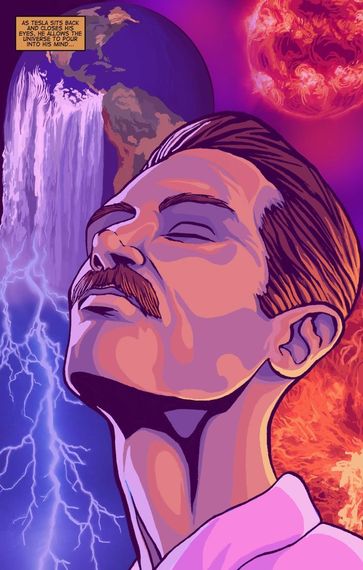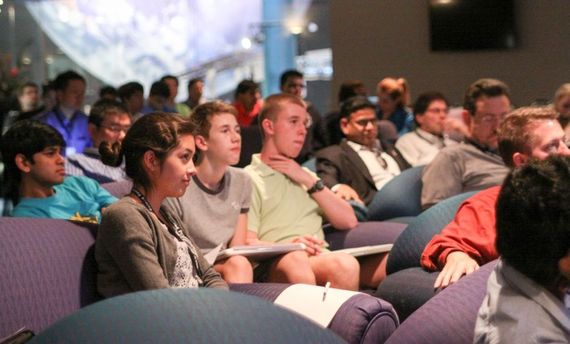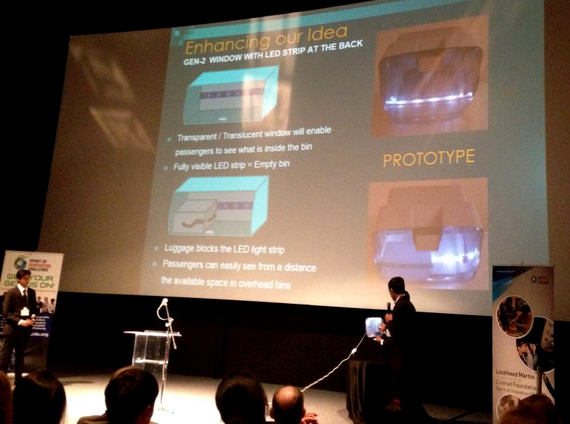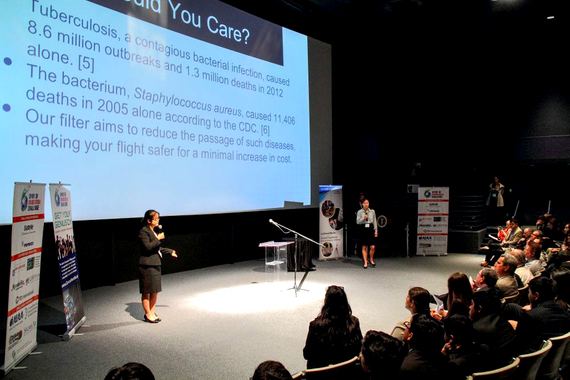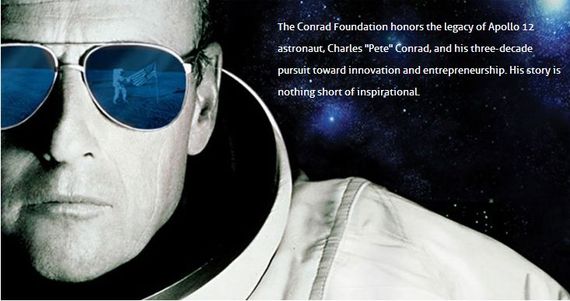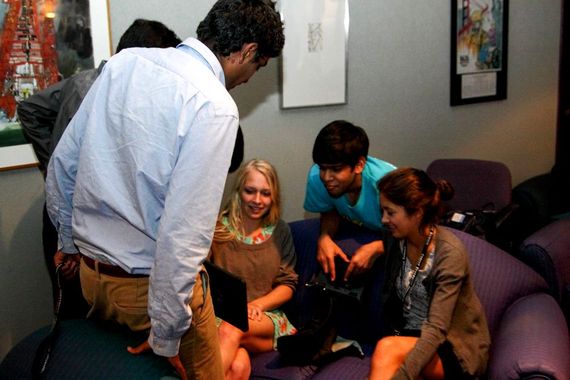"The progressive development of man is vitally dependent on invention. It is the most important product of his creative brain. Its ultimate purpose is the complete mastery of mind over the material world, the harnessing of the forces of nature to human needs." -- Nikola Tesla, Inventor
The act of creating something is one of the most empowering states a human can experience. Unfortunately, our education system doesn't promote this simple notion and instead focuses on testing our kids on their ability to memorize information and facts, a significant amount of which is rendered inaccurate, obsolete or irrelevant by the time they leave school and enter the workforce. Aside from the basic skills kids learn in school such as reading, writing, and math, the important life skills, such as learning how to conceive and create something of value, is completely overlooked.
However, there is hope!
I recently had the honor of speaking at NASA's Johnson Space Center and what I saw was incredible!
A space pump inspired by parasites that minimizes the need for electro-mechanical parts so we can send a man to Mars. A new compound that can absorb oil at over 200 times its own weight to help clean up oceanic oil spills significantly faster and cheaper than current methods. A bionic hand that allows amputees to reclaim normal hand and finger functionality. A device for water collection that condenses clean water directly out of the atmosphere to be used for farming, drinking and cooling.
However, none of these inventions are from NASA. These products are conceived and developed by high school kids from around the world who compete in the Conrad Foundation's annual Spirit of Innovation Challenge (SOIC).
Every year, over 1,000 high school kids from 72 countries and all 50 states submit to the Conrad Foundation their ideas, inventions and solutions to real world problems in one of four categories - aviation and aerospace, cyber-technology and security, energy and environment, and health and nutrition. The SOIC committee narrows the submissions from over 500 teams down to 20 teams who will compete in a Shark Tank style STEM competition for kids. These final 20 teams come to NASA's Johnson Space Center in Houston to do their venture pitch to a panel of highly credentialed judges ranging from NASA scientists and engineers to successful businessmen and entrepreneurs. This year the winning teams (one for each category) walked away with $47,500 in awards along with access to mentors, potential clients, and other resources to help them commercialize their product or idea, including access to a portion of NASA's patent portfolio.
What happens when kids are inspired and encouraged to exercise their ideas and creativity to solve real world problems?
Innovation from teams like PuzzleBot who created an online security program that replaces CAPTCHAs with picture puzzles that are faster to validate and web bot hack resistant. Team XC Walking Watts, developed a shoe that can store the piezo-electric energy derived from walking so you can charge your phone or other device while on the go. The Green Barriers team created the HydroBucket that allows trees to grow in harsh vegetation-deprived areas to help fight off the effects of global warming and desertification in regions like Africa.
However, these teams didn't stop just with their product idea or prototype. I was one of the judges for the energy and environment category, and these kids came in with a full market analysis, go-to market strategy and in some cases a source and use of funds comparable to any proper venture pitch. We asked one team, who were all high school juniors, what they would do if their final prototype was successful. They responded they would take a gap year after high school to focus on taking their idea to market. Now that's passion!
The Conrad Foundation was founded in 2008 by Nancy Conrad in honor of her late husband Charles "Pete" Conrad, commander for the Apollo 12 mission and the third man to walk on the moon. The STEM entrepreneurship contest was inspired by Pete's personal story who failed out of 11th grade due to dyslexia, which was not recognized or understood at the time. However, Pete's mother did not give up on him and found a school headmaster that would take him on and teach him through a systems learning approach. Pete did so well that he graduated from high school, and was admitted to Princeton University with a full Navy ROTC scholarship. After graduating from Princeton with his B.S. in aeronautical engineering, Pete was immediately commissioned to the Navy where he later became a naval aviator and fighter pilot, and ultimately a NASA astronaut. After many years of risky space exploration, Pete turned his talents and experience towards entrepreneurship and founded four companies devoted to the commercialization of space travel.
Pete's ideals to inspire and empower kids to invent and innovate still lives on today through the foundation. Previous winners have garnered significant support and recognition such as Daniel and Issac who obtained two patents for their invention and were recognized by the Chairman of the Federal Energy Regulatory Commission. Another team duo, Mikayla and Shannon, created a nutritional bar for astronauts which flew on the Space Shuttle STS-134 flight and was profiled by Fox News, CNN, and MTV Geek. They were later commissioned as student spokeswomen for Texas Instrument. Another team developed the ULTRApod Water Filter and began manufacturing their prototype after attending the 2012 USA Science and Engineering Festival as guests of Lockheed Martin.
Conrad Foundation is one of several high-profile STEM competitions focused on encouraging high school kids to think differently. A couple years ago at the Chicago Ideas Conference, I met Jack Andraka who was a 15 year old high school sophomore when he won the Intel International Science and Engineering Fair for developing a new diagnostic test for early detection of pancreatic cancer, the very disease Steve Jobs passed away from. Jack's testing approach is 90 percent accurate and also 168 times faster, 400 times more sensitive, and 27,000 times cheaper (3 cents per dipstick) than previous testing methods.
However, even the most revolutionary ideas are not enough on their own. There are big leaps that must take place to take these ideas and inventions to market and gain market acceptance and ultimately become financially solvent. As Nikola Tesla discovered in his epic journey to bring electricity to the world, the technical problems were relatively easy to resolve. The bigger hurdles were timing, competition, politics, finance, customer acquisition, team chemistry, relationships, greed, ego, fear, envy, public perception, expectations and all things human. Yet as every successful entrepreneur learns, we never get it completely right on the first try. Entrepreneurship is an on-going iterative learning process and the sooner one starts, the more they learn and the better their chances to create viable solutions that can gain wide-spread market adoption. The kids in these high school STEM contests are between the ages of 13 and 18 years, so they're off to a really good start.
How can we apply this approach to our education system and engage millions of kids to think differently and truly foster a culture of inventors and innovators?
To start, we must restructure our current high school educational approach to reflect how the real world operates. Instead of vertical subjects, the curriculum should be reorganized into civilization based themes such as Energy, Environment, Food, Water, Health, Communication, Education, Transportation, Finance, Government, Infrastructure and other important societal systems. Each theme could be developed into a nine-week quarter with a set of over-arching humanity serving goals and limitations the sector is facing. During this time the students would form teams and learn about the subjects relevant to the theme such as its history, science, technology, law, governmental policies, finance, politics, international relations, economics, and more. In this process, each team can divide the workload to do a deeper dive into the subjects so they can teach each other faster than a single subject teacher could teach a class. Then the teams would identify problems for which they would develop innovative solutions. These solutions would then be presented in class initially and the best ideas and presentations would be presented to the entire school, so other students can learn from their approach thus setting a higher bar. This could also be expanded to the region, state and nation through some sort of competitive evaluation process with real financial awards, incentives and scholarships.
There are significant benefits to this theme-centric approach. First, our kids would transform their learned information into actual knowledge by applying it towards tangible goals, instead of turning themselves into a human database of useless facts with no practical application. By practicing how to think through and create solutions to real world issues, the kids would learn how to be resourceful and feel more empowered to make a difference in the world. This would result in higher student engagement and our kids would gain a much deeper understanding of what they enjoy and want to focus on after school. Most importantly, our kids would have an immediate value contribution to society with real world economic impact thus generating a significantly better return on our educational tax dollars.
As our governments, banking systems and industrial complexes continue to confound our future by exploiting our energy, environment, health, food supply, water, education, financial, economic, transportation and other societal systems, our only hope to save and evolve humanity is for our future generations to clean up our politico-industrial backwash. If we can develop a better system to engage, empower and enable our children to innovate faster than our world systems decay, then our kids could not only save our world, they could reinvent our future!
